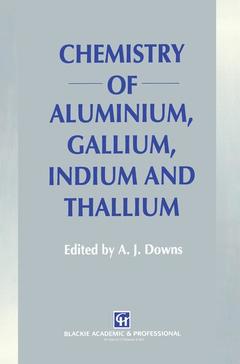Chemistry of Aluminium, Gallium, Indium and Thallium, Softcover reprint of the original 1st ed. 1993
Langue : Anglais
Coordonnateur : Downs A.J.

Boron has all the best tunes. That may well be the first impression of the Group 13 elements. The chemical literature fosters the impression not only in the primary journals, but also in asteady outflowofbooks focussing more or less closely on boron and its compounds. The same preoccupation with boron is apparent in the coverage received by the Group 13 elements in the comprehensive and regularly updated volume of the Gmelin Handbook. Yet such an imbalance cannot be explained by any inherent lack ofvariety, interest or consequence in the 'heavier elements. Aluminium is the most abundant metal in the earth's crust; in the industrialised world the metal is second only to iron in its usage, and its compounds can justifiably be said to touch our lives daily - to the potential detriment of those and other lives, some would argue. From being chemical curios, gallium and indium have now gained considerably prominence as sources of compound semiconductors like gallium arsenide and indium antimonide. Nor is there any want ofincident in the chemistriesofthe heavier Group 13 elements. In their redox, coordination and structural properties, there is to be found music indeed, notable not always for its harmony but invariably for its richness and variety. Thisbook seeks to redress the balance with a definitive, wide-rangingand up-to-date review of the chemistry of the Group 13 metals aluminium, gallium, indium and thallium.
Overview. The elements. Inorganic derivatives of the elements. Properties and uses of solid oxides. Properties and uses of other solids: metals, semi-metals, and semiconductors. Organometallic compounds. Organic transformations mediated by group 13 metal compounds. Coordination and solution chemistry. The elements in the environment. Analytical methods. References. Index.
Date de parution : 10-2012
Ouvrage de 526 p.
15.5x23.5 cm
Thèmes de Chemistry of Aluminium, Gallium, Indium and Thallium :
© 2024 LAVOISIER S.A.S.


